Top thirty-four with 76,2-mm cannon, or T-34 of model 1943 of year against T-IVH
Thus, at the beginning of the 1943, the T-34 lost the status of a tank with an anti-bullet reservation. What did our designers do?
T-34-76 sample 1943 g
In principle, the T-34 design had certain reserves by weight and allowed to increase the thickness of the reservation, however, this was not done. The main changes of the thirty-fours in the first half of 1943 were to increase engine life, improve ergonomics and increase the situational awareness of the tank.
The “flaming heart” of the T-34, the B-2 diesel engine, after ridding it of “childhood diseases”, was a high-quality and completely reliable tank engine.
Nevertheless, he often failed before the deadline due to the abominable work of air cleaners. The Chief of the Red Army Central Intelligence Directorate, 2, Major General Tank Xpov, who oversaw T-34 tests at the Aberdeen Proving Ground, noted: “The flaws of our diesel engine are criminally poor air purifiers on the T-34 tank. Americans believe that only a saboteur could construct such a device. "
During 1942, the situation improved somewhat, but still our tanks received really high-quality air purifiers "Cyclone" only in January, 1943. And this significantly increased the life of their engines. The latter now often even exceeded the table values.
The second important innovation was the transition to a new five-speed gearbox. As far as the author could understand, for the first time it was used on T-34 in March 1943, and in June it was already used everywhere in all tank factories that produced T-34. In addition, the design of the main clutch was slightly upgraded, and all this together led to a significant simplification of the work of the driver. Until that time, the management of the tank required a lot of physical strength, in certain circumstances, the force on the lever had to reach 32 kg. In addition, it was very difficult to “stick” a new gear while the main friction clutch was running, but to burn it was very easy, which made it easier for many tankers to attack. They included the 2 starting gear, but at the same time they removed the rev limiter from the engine. This brought the diesel to the speed of rotation in 2 300 rpm, and the speed of the tank on this transmission to 20-25 km / h, which, of course, greatly reduced engine life.
The new gearbox and advanced clutch did not require any “miracle heroes” behind the levers of the tank, nor the conduct of the battle in one gear. The management of the T-34 after these innovations has become quite satisfactory. Although the T-34 transmission did not become exemplary and still contained a number of deliberately archaic solutions, but after these innovations, the thirty-four really became reliable and unpretentious in operation and easy to manage.
A huge step forward made the observation of the tank. Unfortunately, the narrow shoulder strap did not allow the introduction of the fifth crew member and thus divide the duties of the gunner and the tank commander. Nevertheless, in terms of situational awareness, the crew of the T-34 produced in the summer of 1943 was an order of magnitude superior to the “thirty-four” earlier models.
On T-34 rev.1941, the tank commander had a panoramic PT-K device and two periscopic instruments located on the sides of the tank. Alas, PT-K was not quite good in design, and most importantly, it was installed extremely unsuccessfully. Although theoretically he could provide an overview on 360 hail., In fact, the T-34 commander could only see ahead and the 120 hail sector. to the right of the direction of movement of the tank. Side "periscopes" were extremely uncomfortable. As a result, the review of the commander of the T-34 arr. 1941 was very limited and had many "dead" inaccessible areas for observation.
Another thing - the commander of the T-34 arr. 1943. From the summer of this year, at thirty-four, a commander's turret, equipped with 5 sighting slits, finally appeared on it, and the MK-4 periscopic periscope device with an 360-degree view was located on it. Now, the commander could quickly examine the battlefield using the reticle, or thoughtfully study it with the help of the MK-4, which is much more advanced than the PT-K.
According to one of the domestic "gurus" in stories tanks M. Baryatinsky, MK-4 was not a Soviet invention, but a copy of the English device Mk IV, which was installed on British tanks that entered the USSR under lend-lease. Of course, our military and designers carefully studied the "lend-lease" equipment, and made a list of successful decisions of foreign tanks, recommended for introduction on the domestic armored vehicles. So, the Mk IV device usually occupied the very first line in this list, and one can only regret that the MK-4 did not go into the series before. This is all the more insulting because according to the data of the same M. Baryatinsky, the Mk IV was produced under license in England itself, and the inventor was Polish engineer Gundlach. In the USSR, the design of this device was known at least since 1939, when Polish tanks 7ТР were at the disposal of our military!
Anyway, T-34 arr. 1943 was one of the most advanced observation instruments in the world, and its location on the commander's turret hatch provided excellent viewing sectors. Nevertheless, many tankers in the memoirs noted that in battle they practically did not use the capabilities of the commander's turrets, and sometimes the hatch was kept completely open. Naturally, in such a position to use the commanding MK-4 was impossible. Why is that?
Let's go back to T-34 arr. The 1941 of the Tank was equipped with a TOD-6 telescopic sight, with the help of which the commander, playing the role of the gunner, pointed the tank gun at the target. This sight was very perfect in design, the only significant drawback was that his sighting device changed position with the gun: thus, the commander had to bend down more and more, the higher the angle of elevation of the gun. Yet TOD-6 was completely unsuitable for monitoring the terrain.
But on the T-34 arr. 1943, the commander, performing duties as a gunner, had at his disposal not one, but two sights. The first, TMFD-7, performed the same functionality as TOD-6, but was more sophisticated and of higher quality. Nevertheless, he, of course, was not suitable for observation: in order to inspect the battlefield from TOD-6 or TMDF-7, it was necessary to rotate the entire tower. However, the commander of the modernized “thirty-four” had a second, periscope sight PT4-7, which, having all the same viewing angle in 26 degrees, could rotate on 360 degrees. without turning the tower. In addition, PT4-7 was located in close proximity to TMDF-7.
Thus, in a battle, the commander, wishing to explore the terrain, had the opportunity, without changing his body position, to “switch” from TMDF-7 to PT4-7 - and this was enough for many, so many commanders didn’t really feel the need to use a commander's turret and MK-4. But this did not make the latter useless - in the end, even when participating in a battle, the tank does not always lead a firefight, and, being, for example, in ambush, the commander had the opportunity to use the reticle of the commander's turret and MK-4.
In other words, the provision of a commander in both of his guises — the commander and gunner of a tank gun — has improved qualitatively. But that was not all. The fact is that in T-34 arr. 1941. The loader had almost no review, except for the ability to use the tank commander’s lateral periscopes. There was practically no sense to this, due to the extremely unfortunate location of the latter.
But on the T-34 arr. 1943, the loader, had its own MK-4 device placed on the roof of the tower and having a full-fledged, although, apparently, not a 360-degree survey - it was probably limited by the commander's turret. In addition, at the disposal of the loader there was an 2 reticle.
The driver mechanic received more convenient means of observation, consisting of two periscope instruments. As for the gunner-radio operator, he also received a "new dress", a diopter sight instead of an optical one, but this almost did not affect anything: this crew member both was and remained almost "blind."
At the end of the story about observation devices on T-34 arr. 1943 G. should mention the quality of optics. Frankly speaking, the quality of the German instruments remained unsurpassed, but our pre-war optics, although it was somewhat worse, nevertheless answered its tasks. However, the Izyum optical glass factory, which was engaged in its manufacture, was evacuated in 1942, which, alas, had a strong impact on the quality of its products. However, the situation was gradually improving, and by the middle of 1943, manufacturers were able to provide quality that is quite comparable to world-wide.
In other words, by about the middle of 1943, the Red Army tank crews finally got the tank that they dreamed of in 1941 and 1942. - The development of T-34-76 has reached its peak. In this form, the "thirty-four" was produced until September 1944, when the last 174 machines of this type descended from the conveyor of the plant No. 2 (Omsk).
Let's try to compare what happened to the Soviet and German gunsmiths, using the example of a comparison of the T-34 arr. 1943 and the best German medium tank T-IVN, whose production was launched in April 1943.
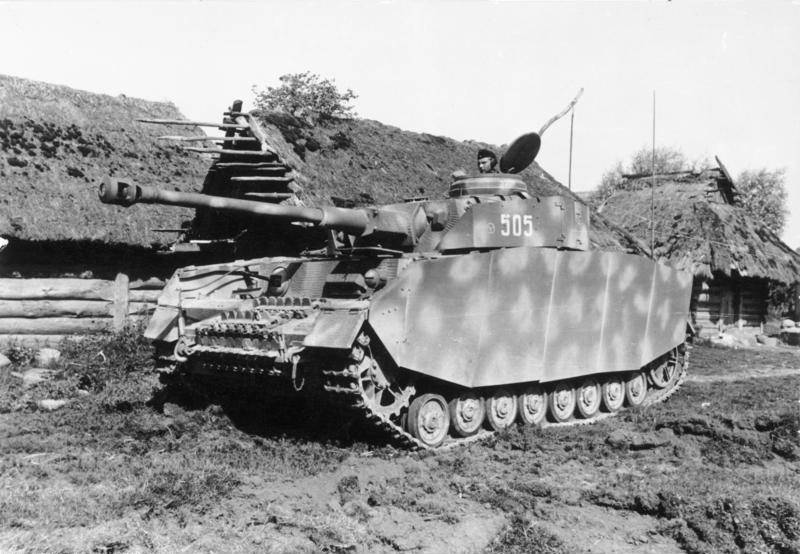
Why was the T-IVH chosen for comparison, and not the later T-IVJ, or the famous “Panther”? The answer is very simple: according to the author, the T-IVH should be considered as the pinnacle of the development of the T-IV tank, but the T-IVJ had some simplifications in its structure designed to facilitate its production, and it was produced only from June 1944. Also It was T-IVH that became the most massive tank of the series - the entire Krupp-Gruzon in Magdeburg, VOMAG in Plauen and the Nibelungenwerk in S. Valentin produced 3 960 of such tanks, that is, almost half (46,13%) of all fours.
As for the "Panther", then, in fact, it was not a medium, but a heavy tank, whose weight fully corresponded to that of a heavy tank EC-2 and surpassed the American heavy tank M26 "Pershing" (the latter, however, later retrained into an average , but this happened after the war). However, later on, the author will necessarily compare T-34-76 and “Panther”, since this will be absolutely necessary for understanding the evolution of the Soviet and German armored forces.
T-34 vs. T-IVH
Alas, a large number of military history buffs argue in a similar vein: the T-IVH's armor thickness reached 80 mm, and the T-34 had all 45 mm, the T-IVH had a long-barreled and much more powerful 75-mm gun than the Soviet F-34 - so what else is there to talk about? And if you still remember the quality of the shells and armor, then it is quite obvious that T-34 lost in all its articles to the brainchild of the “gloomy Teutonic genius”.
However, the devil, as you know, is in the details.
Artillery
The T-IVH was fitted with an excellent 75-mm KwK.40 L / 48, which is an analogue of the Pak-40 towed and had slightly better characteristics than the X -UMG-mm KwK.2 L / 75 mounted on the T-IVF40 and part of the T-IVG . The latter had a construction similar to KwK.43 L / 40, but the trunk shortened to 48 caliber.
KwK.40 L / 48 fired an 6,8 kg caliber armor-piercing (BB) projectile with an initial speed of 790 m / s. At the same time, the domestic F-34 fired 6,3 / 6,5 kg with projectiles with an initial speed of only 662 / 655 m / s. Given the apparent superiority of the German projectile in quality, it is obvious that the armor penetration rate of KwK.40 L / 48 left the F-34 far behind.
True, the Russian projectile had one advantage - a higher content of explosive, of which 6,3 kg BR-350А and 6,5 kg BR-350B were 155 and 119 (according to other data - 65) g, respectively. The German caliber BB PzGr.39 projectile contained only 18, possibly 20 g of explosives. In other words, if the Soviet armor-piercing caliber projectile pierced the armor, its zaronevye impact was significantly higher. But the author is unclear whether it gave any advantages in battle.
In terms of sub-caliber ammunition, KwK.40 L / 48 was also superior to F-34. The German cannon fired 4,1 kg with a projectile with an initial speed of 930 m / s, the Soviet - 3,02 kg with an initial speed of 950 m / s. As is known, the striking element of the sub-caliber ammunition is a relatively thin (of the order of 2 cm) pointed pin of a very durable metal, enclosed in a relatively soft shell, not intended to break the armor. In modern ammunition, the shell is separated after the shot, and in the shells of those times, it was destroyed when striking enemy armor. Since the German projectile was heavier, it can be assumed that, with an almost equal initial velocity, it saved energy better and had better armor penetration with increasing distance than the lighter domestic one.
High-explosive fragmentation ammunition KwK.40 L / 48 and Ф-34 were approximately at the same level. The German projectile at initial speed 590 m / s had 680 g of explosives, indicators of the Soviet RP-350 - 680 m / s and 710 g of explosives. For the F-34, O-350A cast iron grenades with a reduced explosive content in 540 were also used, as well as older ammunition, which should have been fired with a reduced initial velocity, but which were loaded to 815 g of explosives.
In addition, the F-34 could use the case and shrapnel ammunition, which was not in the assortment of the German cannon: in turn, cumulative ammunition was produced for KwK.40 L / 48. However, it is likely that in 1943 g, neither of them was widely used.
Thus, the German artillery system apparently surpassed the domestic F-34 in terms of impact on armored targets, which is not surprising - after all, KwK.40 L / 48, unlike F-34, was a specialized anti-tank weapon. But in the “work” on unarmoured targets KwK.40 L / 48 had no particular advantage over F-34. Both guns were quite convenient for their calculations, but the Soviet was much technologically easier. Sights had quite comparable capabilities.
Reservation
Protection T-34 arr. 1943 r. Increased slightly compared to its previous modifications. A brief description of it can be given as follows: “all by 45 mm”. T-34 arr. 1940 g. 40 mm had a booking of hull sides where the armor plates were tilted, as well as in the stern. The gun mask also had only 40 mm.
T-34 arr. 1943. In all cases, the thickness of the armor reached 45 mm. In cases where cast turrets were used on T-34, their thickness increased to 52 mm, but this did not give an increase in protection: the fact is that cast bronestal has a lower resistance than rolled, so in this case the thickening of armor only compensated her weakness At the same time, the T-34 reservation had rational angles of inclination, which in a number of combat situations allowed us to hope for at least 50-mm and, in some cases, 75-mm caliber to ricochet the enemy projectile.
As for T-IVH, everything turned out much more interesting with it. Yes, the thickness of his armor really reached the 80 mm, but never to be forgotten that such a thickness in the entire tank had exactly 3 armor. Two of them were located in the frontal projection of the tank, another one - defended the commander's turret.
In other words, the T-IVH was very well protected in frontal projection, only 25 or even 20 mm armor plates, which is located between the bottom and top 80 mm bronelists, raise doubts. Of course, its slope in 72 hail. should have guaranteed a rebound, but theory and practice are two different things. As we know, the creators of the T-34 faced situations where small-caliber shells would seem to have ricocheted from “rationally tilted” armor, but for some reason did not.
The forehead of the T-IVH tower had, in general, protection similar to the T-34 - 50 mm. But everything else defended much worse - the boards and feed of the Quartet, had only 30 mm protection without rational tilt angles. The T-IVH shielded the sides of the hull and (less often) the turret, but the thickness of the screens was only 5 mm. They were intended solely to protect against cumulative ammunition, and practically did not give an increase in armor against other types of projectiles.
"Attack and defense"
And now - the most interesting. In general, the following can be said about the protection of the T-IVH: in the frontal projection, it slightly surpassed the T-34, and from the sides and the stern it was very much inferior to him. I foresee wrathful replicas of supporters of German armored vehicles, they say, how can one compare the 80 mm "forehead" of T-IVH and the inclined 45-mm armor plates of T-34? But let me have a few facts. M. Baryatinsky pointed out that
“Repeated tests of tank shells on NIBTPolygon showed that the upper frontal sheet, which had a thickness of 45 mm and angle of inclination of 60 degrees, was equivalent in equipment resistance to a vertically positioned armor sheet with a thickness of 75 – 80 mm.”
And yet - the tabular armor penetration of Pak 40 was, according to German data, about 80 mm on 1000 m. It punched the frontal armor of the T-34 tower at the 1000 m distance, but here the nasal armor player - only at the distance to 500 m., As evidenced by including, here is this memo calculation Pak 40
Of course, the T-IVH had a more powerful gun, but what advantages did it give it? If we consider the “head-on” confrontation, then at a distance from 500 to 1000, the German tank punched only the frontal parts of the T-34 turret. But the tabular values of the F-34 armor penetration guarantee the same result for 50 mm armor plates of the forward part of the T-IVH turret, and in practice it came about that way - at least using solid metal projectiles that did not contain explosives. Another thing is the distances to 500 m, at which the frontal projection of the T-34 has already been made its way anywhere, but the frontal armored T-IVH - only with projectiles. The author, unfortunately, did not find the results of the shelling of 20 or 25 mm of armor plate T-IVH, which connected two 80 mm of armor details. Did this armor withstand the blows of domestic 76,2-mm armor-piercing caliber shells?
However, it is worth noting other points of view. For example, the same M. Baryatinsky quotes an excerpt from a report made on the basis of 23’s experience with the Wehrmacht’s tank division that “T-34 is attacked at any angle to any projection if the fire is fired from a distance of no more than 1,2 km” speech, oddly enough, is not even about KwK.40 L / 48, but about KwK.40 L / 43. But this could be the result of erroneous observation, yet the experience of one division may not be entirely indicative. Observations of our military said that the forehead of the T-34 case could have been pierced with a KwK.40 L / 48 projectile at a distance of 800 m - and this is not a guaranteed defeat, but that there were no cases when the T-head -34 made his way from a greater distance. Thus, it is possible that at angles close to optimal, the forehead of the T-34 body could be pierced and with a slightly larger distance than the 500 m, but most likely, a reliable defeat was achieved with the 500 m.
As for the sides and the stern, then everything is simple - and the T-34 and T-IVH confidently hit each other in these projections at any conceivable distances of artillery combat.
And here we come to a rather strange, at first glance, conclusion. Yes, the T-IVH had armor in the 80 mm (here and there!) And a very powerful 75-mm gun, but, in fact, it did not give him an overwhelming advantage over the T-34 mod. 1943 d. The German tank reservation scheme gave him superiority — and not absolute, only at a distance to 500 m or a bit more when shooting head-to-head. But otherwise, the T-IVH defense completely lost to the T-34.
One should never forget that tanks are not fighting against each other in a spherical vacuum, but on the battlefield with the entire nomenclature of enemy fire weapons. And for medium tanks of the WWII era, the struggle with enemy tanks, oddly enough, was not at all the main combat task, although, of course, they should always be ready for this.
The T-34 with its anti-shell booking made the Germans evolve towards an increase in the caliber of VET to 75 mm. Such guns successfully fought with the T-34, but at the same time just as "successfully" limited the capabilities of the Wehrmacht. The author came across information that the batteries of the Pak 40 towed could not carry out all-round defense - after several shots the coulters buried so deep into the ground that pulling them out to deploy the gun became a completely non-trivial task that could not usually be solved in fight That is, after entering into battle to deploy the guns in the other direction was almost impossible! And in the same way Pak 40 did not allow movement by the forces of calculation along the battlefield.
But T-IVH, which had comparable armor to T-34 only in a frontal projection, could never have caused such a reaction - its 30 mm beads were surely struck not by the fact that 57-mm ZiS-2, but also by good old “forty pimples” . In fact, it was very dangerous to use tanks of this type against a properly organized defense with overlapping sectors of the flank VET-fire, even if they are driven by mobile and mobile guns of small calibers. We illustrate all the above with the example of T-34 damage according to the analysis of the Central Research Institute No. 48, conducted in 1942, on the basis of a study of padded Thirty-Fours. So, according to this analysis, the hits were distributed as follows:
1. Hull sides - 50,5% of all hits;
2. The forehead of the body is 22,65%;
3. Tower -19,14%;
4. Feed and so on - 7,71%
It is possible that for the T-IVH, the crew of which had a significantly better visibility than the crew of the T-34 model 1942, this ratio was better because the Germans were probably less likely to allow them to board. But even if for the T-IVH such hits in the nose and sides of the hull were distributed approximately equally, then even then no less than 36,5% of all the shells that fell into it would have fallen on its sides! In general, the protection of the side projection is not at all the whim of the creators of the tanks, and the sides of the T-IVH were “cardboard” and could not take a hit at all.
It can be stated that T-IVH had certain duel advantages over T-34, but at the same time it was much more vulnerable on the battlefield. At the same time, the more powerful T-IVH gun did not give him any advantages in the fight against field fortifications, machine-gun nests, artillery and unarmored equipment compared to T-34.
Surveillance tools
Here, oddly enough, it is difficult to determine the winner. The undoubted advantage of the T-IVH was the fifth crew member, with the result that the duties of the tank commander and gunner were separated. But the crew of the T-34-76 was equipped with much better technical equipment.
Commander T-IVH had at his disposal a commander's cupola with its 5 reticle, but that was essentially all. She, of course, gave a good overview of the battlefield, but on T-34 arr. 1943, the commander received the same, and the MK-4 and PT4-7 with an increase, allowed him a much better view of the threatened direction, to identify the target. The German commander needed to get out of the hatch, get the binoculars ...
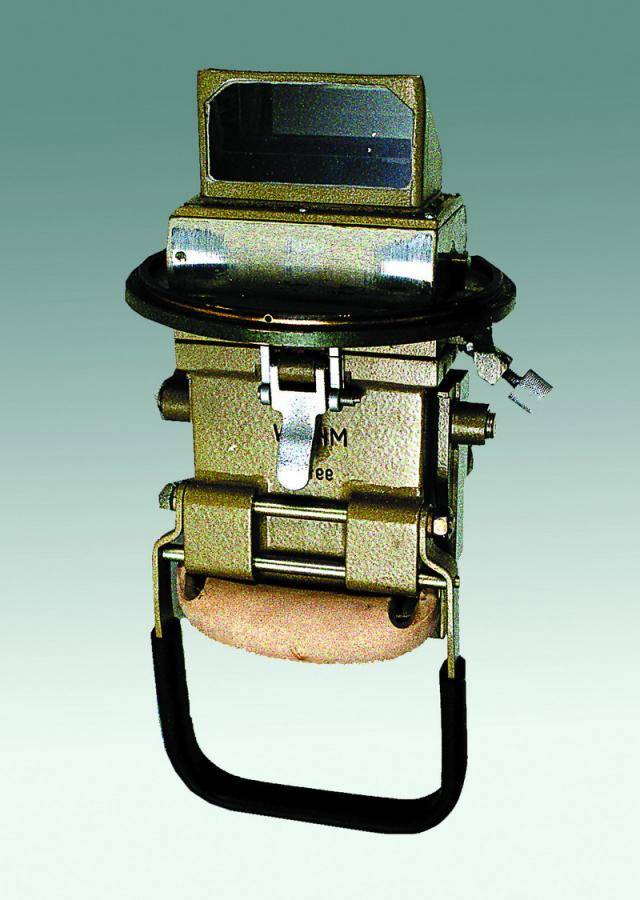
In the crew of the T-IVH, only one tank commander had a review in 360 hail. But in the T-34, devices MK-4 and had a commander and loader. That is, in the event of an extreme need (for example, a tank is opened at the fire), the crew of the T-34 was probably more likely to find out from whence and who, in fact, shoots.
It must be said that on previous versions of the T-IV, the crew review was better - the same loader in the T-IVH was completely “blind”, but in the T-IVG, for example, it had 4 reticle in its eyes, which could not be seen only he, but also the gunner. But on the T-IVH screens were installed, and from these sighting slots had to be abandoned. Thus, the only gunner's device was a tank sight, and he, for all his merits, was not suitable for a review of the terrain.
The T-34 and T-IVH driver mechanics were about equal in capabilities — the German tanker had a good periscope device and a reticle, our 2 periscope device and a driver's hatch, which overall was, perhaps, more convenient than a slot. The loser member of the Soviet crew was only the gunner-gunner - although he had a diopter sight, his viewing angle was too small, and his German counterparts 2 provided a slightly better view.
In general, perhaps, it can be argued that the T-34 crew was very close to the T-IVH in terms of awareness, if there was a difference, it was not very significant. And, by the way, is no longer a fact that in favor of the German tank.
Ergonomics
On the one hand, the German crew had certain advantages - a wider shoulder strap for the tower (but not the 2 of the person, but the 3), but better conditions for the loader. But on the other hand, the Germans had to save on the T-IVH. In his memoirs, a number of Soviet tankers expressed their complaints about the work of the electric motor, which turned the tank turret. Well, on some T-IVHs the mechanical turning devices were generally considered unnecessary overkill, so the tower was rotated by hand. Someone complained about the T-34 mechanic optics (complaints, by the way, related mainly to the “thirty-fours” of 1941-42 samples)? So some T-IVHs did not have a periscope observation device at all, and the driver only had a reticle. In general, on the T-IVH, the only optical devices were the gunner’s sight only, and the tank commander’s binoculars. Undoubtedly, T-IVH was more convenient to manage, but on T-34 the situation in this regard has improved dramatically. On average, perhaps, the German tank was still superior to the T-34 in terms of convenience, but, apparently, it was already impossible to say that ergonomics significantly reduced the potential of the thirty-four.
Chassis
Of course, the German transmission was more perfect and better. But T-IVH, having a mass of 25,7 t, was driven by a petrol engine with a power of 300 hp, that is, the specific power of the tank was 11,7 hp per ton. And T-34-76 arr. 1943, with a mass of 30,9 t, had a 500-strong diesel, respectively, its specific power was 16,2 hp / t, that is, by this indicator more than 38% exceeded its German "opponent". The specific pressure on the ground of the German tank reached 0,89 kg / sq. Cm, and for the T-34 - 0,79 kg / sq. Cm. In other words, the mobility and permeability of the T-34 left the T-IVH far behind.
Cruising on the highway at the T-IVH was 210 km, at the T-34 - 300 km and, unlike the “thirty-fours” of previous years, the T-34 mod. 1943 could really cover such a distance.
As for fire hazard, then the question is very difficult. On the one hand, gasoline, of course, is more combustible, but the T-IVH tanks with fuel were located very low, under the fighting compartment, where they were threatened only by explosions on mines. At the same time, the T-34 fuel was located on the sides of the crew compartment. As it is known, diesel fuel doesn’t burn much, but its vapors could well cause detonation. However, judging by the available data, such a detonation could have caused no less than an 75-mm projectile that exploded inside the tank, if the latter had little fuel. The consequences of such a detonation were, of course, terrible, but ... Would it be much worse if the T-34 tanks were located elsewhere? Detonation 75 mm projectile in the fighting compartment and so almost guaranteed the death of the crew.
Perhaps we can say this: the use of a diesel engine was an asset of the Soviet tank, but the location of its fuel tanks was a disadvantage. But in general, there is no doubt that each tank, on the part of the engine and transmission, had its advantages and disadvantages and it is difficult to choose the undisputed leader, but the T-34 may well claim to be in the first place.
Combat potential
In general, it can be stated that T-IVH and T-34 arr. The 1943 was a machine of roughly equal combat qualities. T-IVH was slightly better in tank combat, T-34 - in the fight against infantry, artillery and other unarmored targets. Interestingly, both tanks fully complied with the requirements of the moment. For the Germans, the time of the blitzkrieg was irretrievably gone, for them the tasks of confronting Soviet tank wedges that had broken down the defenses and escaped to operational space, came to the forefront, and T-IVH coped better with this task T-34. At the same time, the era of deep operations was approaching for the Red Army, in which they needed an unpretentious and reliable tank capable of long-range raids and focused on quick defeat and suppression of rear structures, troops on the march, field artillery on positions and other similar goals in the depth of the enemy’s defenses . This is T-34-76 arr. 1943 G. "knew how" to do better T-IVH.
Manufacturability
According to this parameter, T-IVH with a bang lost T-34. While the T-34 hulls were formed using automatic welding machines, the operators of which did not require high skill, and the towers were made either in the same way or were cast, the hulls of German tanks were a real work of art. The armor plates had special fastenings, they seemed to be inserted into each other (on dowels), and then they were welded by hand, which required a lot of time and highly skilled workers. That's just what was the point in all this, if all these efforts ultimately did not lead to any noticeable superiority of T-IVH in defense against T-34? And the same could be said about any other unit.
As a result, the Germans spent a lot of effort and time to create a combat vehicle ... who had no visible superiority over the much simpler and easier to manufacture T-34-76 arr. 1943
To be continued ...
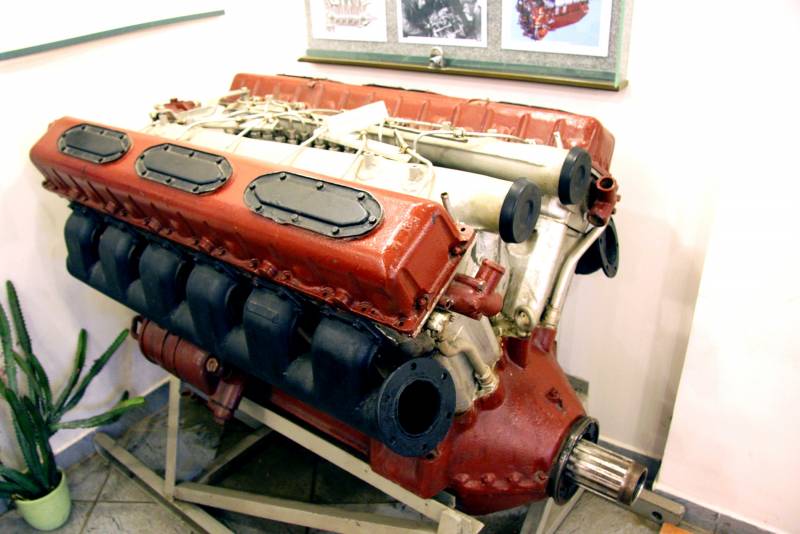
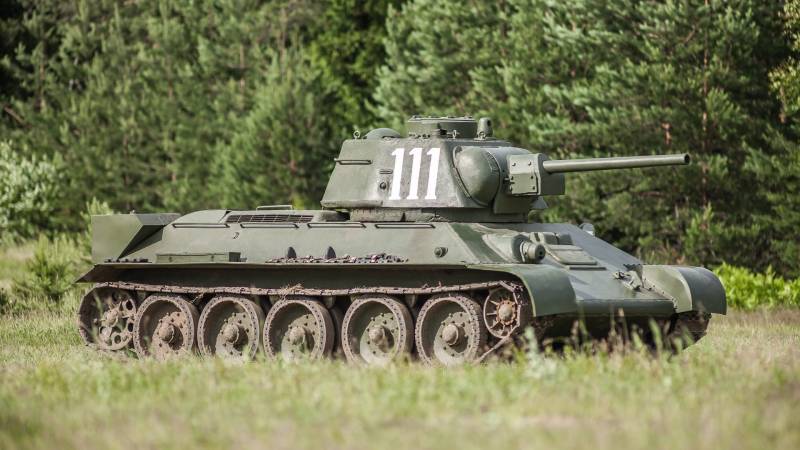
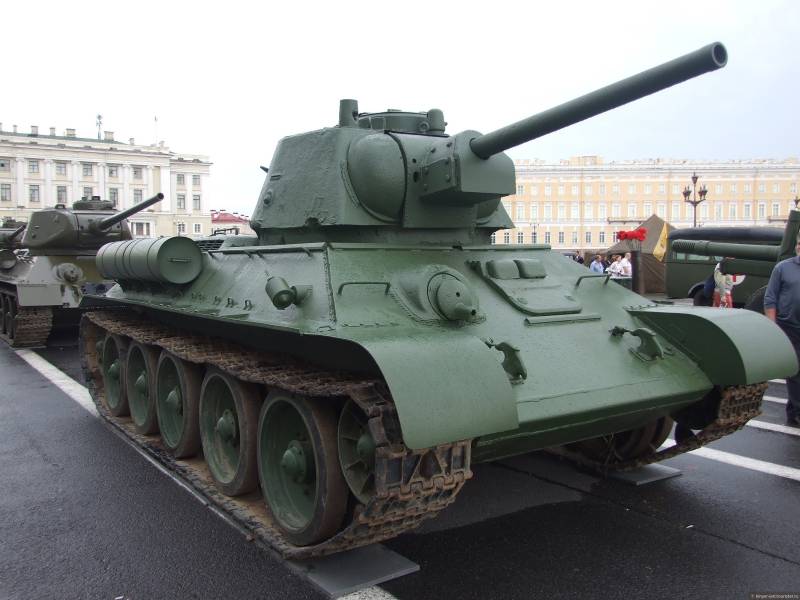

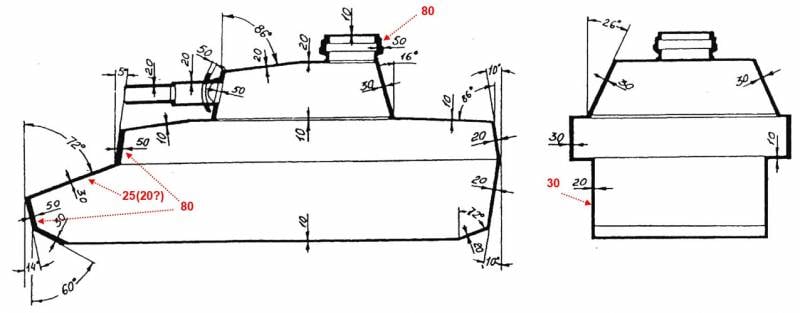
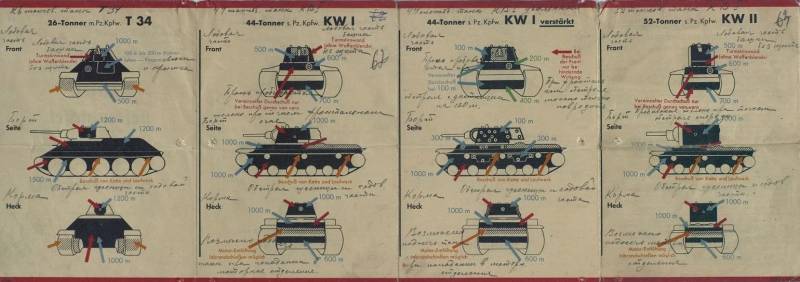
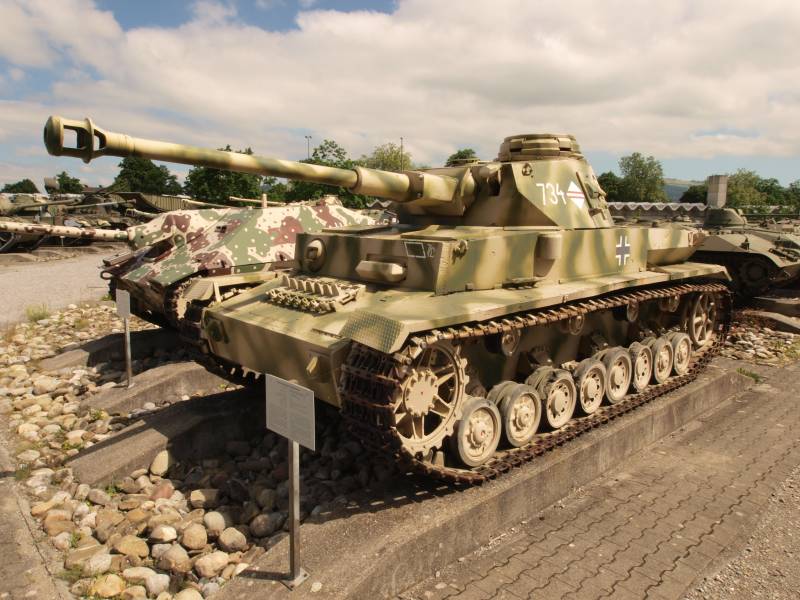
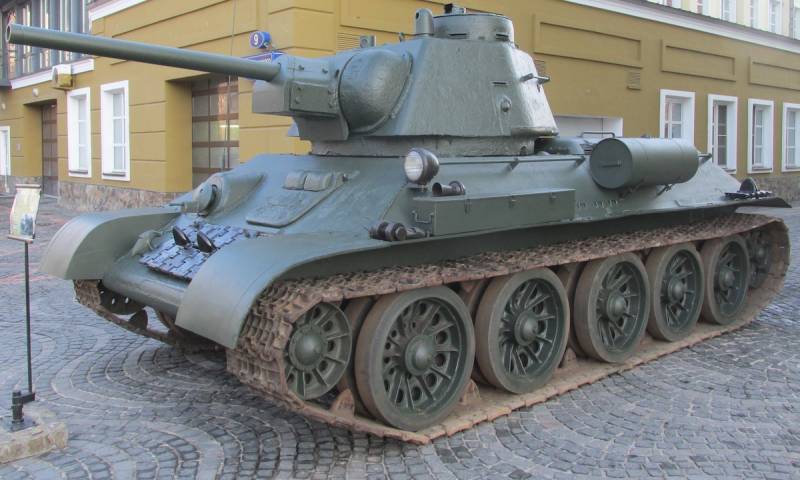
Information